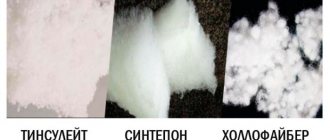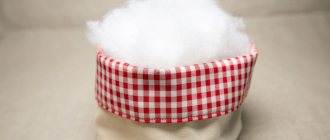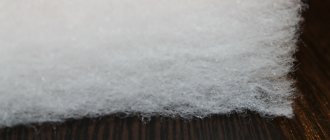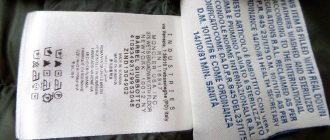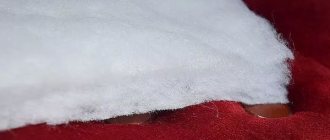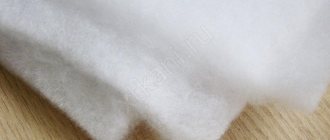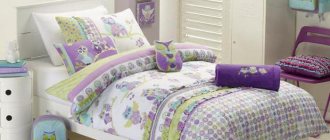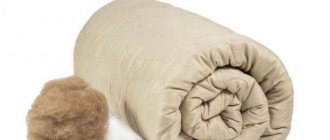It has long been known that not every jacket can keep you warm. You need to be able to choose a good one. But how you want to have light, warm and practical clothes! One that breathes, creates a feeling of comfort in a wide range of temperatures, can withstand washing/dry cleaning without problems, and costs a reasonable amount of money.
If you are looking for a jacket for the winter and don’t know which insulation is better, then this article will help you. From it you will learn the answer to the question: “What to choose: Holofiber or Thinsulate?”
Why these insulation materials? Because today these are the best solutions among all existing artificial insulation materials used as fillers in the production of demi-season and winter outerwear. They can only compete with natural fluff, but that’s a stretch.
Thinsulate
Thinsulate insulation was originally developed for NASA spacesuits. But a few years later, the general public learned about it, and the material began to be used in sportswear. For the first time, for “civilian” purposes, it was used in equipment for skiers and clothing for researchers of the Far North. Only in the 2000s did he gain real popularity. Now Thinsulate is everywhere: in coats, blankets, shoes and even toys.
Advantages of Thinsulate
This is a synthetic non-woven material. It is made from hundreds of thousands of ultra-fine fibers combined into one fabric. That is why it will keep its shape even after being in a vacuum bag.
- Thermal insulation. Due to its structure, the material acts as an excellent insulator. You won't be cold as it will retain your body heat and provide extra warmth. But therein lies the danger: you can overheat in warm weather. Therefore, there is no need to wrap yourself in Thinsulate if it’s +20 outside!
- Ease. The insulation fibers are thinner than human hair. Therefore, even despite the density, the material remains quite light and thin.
- Elasticity. The fiber can take on any shape, which is convenient for athletes, as it provides complete freedom of movement.
- Safety. The material is not flammable; even when in contact with an open fire, it does not burn out, but only melts. Thinsulate is also completely hypoallergenic.
- Versatility. It can be used in any area of human life.
- Moisture resistance. Thinsulate does not accumulate moisture and does not absorb water.
- Wear resistance. The filler does not lose its original properties even after several years of active use.
- Ease of care. The main thing is not to wash it in boiling water.
We have NASA astronauts to thank for all this. Just think how often they could change things on the orbital station? That’s why the insulation has collected all the coolest things that could be gotten from it. If Thinsulate could withstand temperatures of -273°C, then Russians -40°C simply do not care for it.
Disadvantages of Thinsulate
Despite all the coolness of the material, it also has its drawbacks. But they cannot be compared with the advantages and now you will understand why.
- High cost of material. You have to pay for quality.
- May cause overheating. This is only possible if you wear things with Thinsulate in warm weather (when the temperature is above +15°C).
- Accumulates static electricity. Long-haired girls will need to check their hairstyle more carefully.
- Difficult to paint. But since it is located inside the fabric, this does not play a special role.
Thinsulate care
- The material does not require special care. You only need to follow a few basic rules:
- Washing should be done in warm or cold water;
- After washing, Thinsulate must be rinsed several times;
- Laundry liquids should be used instead of powders;
- You need to let things dry naturally.
Holofiber
This is another one of the most popular insulation materials. Its structure is similar to a canvas consisting of hollow spirals. They become the insulating layer. The material is homogeneous and at the same time porous.
Production
The raw material used here is a polyester compound processed by the temperature bonding method. After processing, it is passed through a special wind tunnel, where the fibers are soldered into a web using high temperature.
Properties of holofiber
Thanks to a special production method, holofiber has a number of features:
- Strength. The holofiber filler is almost impossible to tear, since the fibers welded under the influence of temperature are incredibly dense.
- Environmentally friendly. Holofiber simply does not contain glue.
- Biological stability. Holofiber does not decompose and does not rot.
- Heat capacity and air tightness. You will not freeze even in the most severe cold, but you will not be haunted by the greenhouse effect during the transition season.
- Elasticity. Anything made from holofiber will return to its shape in a few minutes, even if it has been stored for several weeks in vacuum packaging.
- Soundproofing. It practically does not allow sound to pass through.
- Cheapness. Due to the availability of raw materials, holofiber is a fairly cheap insulation material.
What are the differences
However, there are some differences between the materials. They are the ones who will help you choose which polymer fabric is better.
Holofiber looks more voluminous in the finished product, it takes up more space . The second type prevents freezing even with a layer of several millimeters. This is what explains the desire of manufacturers to use holofiber mainly for everyday things.
In most cases, Thinsulate is used for sewing sports jackets, fitted coats, and suits for long walks in frosty air . Clothes look more elegant, attractive, and thinner. It is more comfortable and easier to move in it.
You will become more familiar with the Thinsulate material by watching this video:
Another important difference is the cost of the product. Domestic-made non-woven fabric is an order of magnitude cheaper than foreign-made filler.
In the following articles we will tell you what Hollophan, Isosoft and Shelter insulation are and where they are used.
Read about the description, performance characteristics and use of Greta fabric here.
Application
Holofiber is added to clothes, pillows, blankets, mattresses and special suits. It is also used in recording studios! How is this possible? Good holofiber has soundproofing properties and therefore can be used as a material for acoustic panels.
Holofiber care
The main rule of care is identical for both insulation materials: do not wash in hot water! But in holofiber you can use intensive washing mode and use powders with bleaches.
Which is better: Thinsulate or Holofiber?
Despite the fact that most of the main advantages of insulation are the same, their differences are obvious. And if we take quality into account, then Thinsulate is head and shoulders above Holofiber. It is more practical, warm and reliable, although it requires careful washing. But if we judge availability, then holofiber still wins. It is almost 5 times cheaper than Thinsulate. Accordingly, a thing with this insulation will cost much less. Therefore, if you were looking for something budget-friendly, you should buy holofiber. Such clothes will last for 1-2 seasons. If your finances allow you to fork out for a warm jacket and boots, buy Thinsulate. Clothes with this insulation can easily last even 10 years.
Visually distinguishing between things with holofiber and thinsulate is quite simple. The first insulation is voluminous, and the second is ultra-thin. When you see women's winter coats on Thinsulate, you may at first think that you have been deceived by providing an autumn coat. But that's not true! The material is so thin that it looks as if it is not there. Thinsulate with a thickness of 4-5 mm will warm you in the coldest cold.
Choose insulation for winter clothes in the OnlineTkani online store according to the characteristics described above.
Placing an order is very simple: add items to your cart and choose a convenient delivery method. Still have questions? Call by phone for advice. Fabric catalog
Top 9 best fillings for winter jackets
Holofiber
Hollow fiber is a popular filling for modern winter jackets. Its peculiarity is good thermal conductivity and light weight, so outerwear retains heat well, but remains weightless. The material is synthetic. Belongs to the group of polyesters. Externally – non-woven fiber, which allows you to feel comfortable even in 30-degree frosts. Jackets filled with holofiber are popular among buyers due to their low price and excellent quality.
Quite a lot of air is retained inside the filler. This allows you not to weigh down bulky winter clothes. Holofiber fibers are connected to each other by soldering using high temperature, without the use of glue. The products are durable. The material does not absorb moisture, and after washing it dries quickly and returns to its original shape. Therefore, jackets can be washed at home in a regular washing machine without fear of ruining things. Most users believe that holofiber is one of the best fillings for winter jackets. Things with it are easy to care for and have no significant drawbacks.
Sintepon
Another popular filler. Jackets with synthetic padding are warm down to -20 degrees. It is light, almost weightless. The insulation dries quite quickly and does not lose its shape. At the same time, things are inexpensive, which cannot but attract buyers.
But its value is not only in cost. The material is hypoallergenic, despite the fact that it is completely synthetic. As part of things, synthetic winterizer is folded into several layers, which allows you to retain heat. It is easy to care for. The filler belongs to the unpretentious series. But there is still a drawback - with repeated washings it gets into clumps.
Isosoft
Very warm synthetic filling for winter jackets. The quality is not inferior to natural ones. Items containing isosoft are thin and light in appearance. Consists of polyester clearly structured microfibers in the form of balls. Air is stored between them, which ensures thermoregulation. Quickly returns to shape. Withstands repeated washing without loss of quality.
The filler is unique in that it retains a lot of air inside, thereby providing warmth for a long time. You can walk in minus 30 degrees without fear in jackets with isosoft. It does not cause allergies, so it is often used in children's clothes. Jackets with this insulation retain an elegant look and lightness without excessive bulk, but at the same time they are very warm. Buyers note high quality. But there is one drawback - winter jackets based on isosoft are more expensive.
Termofin
It appeared on the market not so long ago, but immediately gained enormous popularity among buyers and manufacturers. The filler has high wear resistance, while maintaining an average cost. Termofin is of Finnish origin. As you know, northern residents know a lot about effective ways to preserve heat in cold weather. Jackets based on thermofin have high thermoregulation and meet all quality requirements.
The material is created from bicomponent fibers with a highly developed surface, which are incredibly light in weight. The fabric has a three-chamber structure and reliably protects against frost. This is a filler for new generation winter jackets, from which both men's, women's and children's clothes are sewn. It is safe, it makes warm outerwear that does not absorb odors and has water-repellent properties. Dries well in a ventilated area. In general, users rate the quality of the filler as “excellent”.
Wool
Wool is one of the warmest fillings for winter jackets. This clothing is very comfortable to wear. It is not cold, but not hot either, that is, the body has an optimal opportunity for thermoregulation. This is a completely natural non-woven material that has been used by mankind since ancient times. Modern manufacturers mass produce winter jackets filled with camel and sheep wool. They are durable and practical. They are worn for several years. However, users note some capriciousness of the filler in care. It is also not suitable for people prone to allergies.
Men's coat trends 2021 #Clothing Read more
Shelter
The material has been recently developed. But, despite this, it managed to gain popularity among consumers. “Shelter” translated into Russian means “shelter”, and for good reason. In a jacket with this filling you really feel like you are in a shelter.
In appearance and structure, shelter fibers resemble human hair. Manufacturers glue them together by heating, which allows them to create a durable material in finished form. There is no need to think that the fibers will come apart when washed. Polymers, on the contrary, repel each other. Thanks to its lightness, minimal volume and maximum degree of protection from the cold, shelter is becoming the most popular among modern fillings for winter jackets. It lasts for several years and is safe for health. But quite picky about care. Washing is possible only on a delicate cycle.
Thinsulate
Synthetic material. However, it is not very different from natural ones in terms of heat retention. Thinsulate was used as a filler for winter jackets back in the 70s. It’s not for nothing that when translated into Russian it means “warm insulation.” The material is thin, but this does not prevent the product based on it from exhibiting the highest heat-protective properties. Since the beginning of 2000 To this day, Thinsulate is the most popular material for filling sports winter jackets.
Thermal insulation properties are provided by a large amount of air between the fibers. The material is light and soft to the touch. Winter outerwear with Thinsulate can withstand frosts down to -50 degrees. This delights consumers, because even wearing a thin T-shirt or shirt under such a jacket is not at all cold. On the contrary, warm sweaters and cardigans can easily lead to overheating. If you are still wondering which filler is the warmest for winter jackets, choose Thinsulate.
Pooh
Among the many types of fillings for winter jackets, down is worth special mention. The material is natural, high quality, warm. It weighs little, but heats well. Waterfowl down is used in jackets for its water-repellent properties. This allows you to keep the item in good condition longer. Duck and goose down have the highest ability to retain heat. Such jackets keep you warm in severe frosts down to -35.
Down is universal. It does not absorb sweat and repels moisture. Before use, the material undergoes special treatment, which ensures a long service life. Even harsh Russian winters are not scary in jackets based on this filler. In addition, they are quite cozy and comfortable. But to increase shelf life and preserve appearance, it is important to strictly follow the manufacturer’s care instructions.
Membrane
The membrane is not a filler. But we can’t help but mention it when talking about winter outerwear. This is a special film-like material that adheres to the surface.
There are many tiny micropores on this film, which prevents moisture from passing through it. But you need to keep in mind that the membrane is used only in clothing and shoes for outdoor activities and sports. Just walking or standing in winter in such a jacket will be very cold. It is important to keep the warmth inside the product under the jacket.
You should read this!
Stylish looks for men: how to dress brand new November 19, 2020
24903
24903
How to choose your style: universal rules and recommendations November 27, 2020
1400
1400
A prerequisite when wearing things made of membrane is three-layer clothing. The first layer is thermal underwear made of synthetics or wool to remove moisture. The second is to warm the body, preventing it from cooling down. This can be a thick sweater made of wool or synthetics (fleece, Polartek, etc.). This layer of clothing is designed to retain heat due to the air layer, which does not release heat outside.
And finally, the third layer is the membrane outerwear itself. It does not allow wind to pass through, does not absorb moisture and allows active movement.


